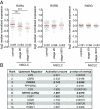Retinoid X receptor suppresses a metastasis-promoting transcriptional program in myeloid cells via a ligand-insensitive mechanism
- PMID: 28923935
- PMCID: PMC5635866
- DOI: 10.1073/pnas.1700785114
Retinoid X receptor suppresses a metastasis-promoting transcriptional program in myeloid cells via a ligand-insensitive mechanism
Abstract
Retinoid X receptor (RXR) regulates several key functions in myeloid cells, including inflammatory responses, phagocytosis, chemokine secretion, and proangiogenic activity. Its importance, however, in tumor-associated myeloid cells is unknown. In this study, we demonstrate that deletion of RXR in myeloid cells enhances lung metastasis formation while not affecting primary tumor growth. We show that RXR deficiency leads to transcriptomic changes in the lung myeloid compartment characterized by increased expression of prometastatic genes, including important determinants of premetastatic niche formation. Accordingly, RXR-deficient myeloid cells are more efficient in promoting cancer cell migration and invasion. Our results suggest that the repressive activity of RXR on prometastatic genes is mediated primarily through direct DNA binding of the receptor along with nuclear receptor corepressor (NCoR) and silencing mediator of retinoic acid and thyroid hormone receptor (SMRT) corepressors and is largely unresponsive to ligand activation. In addition, we found that expression and transcriptional activity of RXRα is down-modulated in peripheral blood mononuclear cells of patients with lung cancer, particularly in advanced and metastatic disease. Overall, our results identify RXR as a regulator in the myeloid cell-assisted metastatic process and establish lipid-sensing nuclear receptors in the microenvironmental regulation of tumor progression.
Keywords: NCoR; metastasis; myeloid cell; premetastatic niche; retinoid X receptor.
Conflict of interest statement
The authors declare no conflict of interest.
Figures






Similar articles
-
Tumor Exosomal RNAs Promote Lung Pre-metastatic Niche Formation by Activating Alveolar Epithelial TLR3 to Recruit Neutrophils.Cancer Cell. 2016 Aug 8;30(2):243-256. doi: 10.1016/j.ccell.2016.06.021. Cancer Cell. 2016. PMID: 27505671
-
Corepressor interaction differentiates the permissive and non-permissive retinoid X receptor heterodimers.Arch Biochem Biophys. 2008 Apr 15;472(2):105-14. doi: 10.1016/j.abb.2008.02.003. Epub 2008 Feb 8. Arch Biochem Biophys. 2008. PMID: 18282463
-
The interaction of the vitamin D receptor with nuclear receptor corepressors and coactivators.Biochem Biophys Res Commun. 1998 Dec 18;253(2):358-63. doi: 10.1006/bbrc.1998.9799. Biochem Biophys Res Commun. 1998. PMID: 9878542
-
Interactions that determine the assembly of a retinoid X receptor/corepressor complex.Proc Natl Acad Sci U S A. 2002 Apr 30;99(9):5842-7. doi: 10.1073/pnas.092043399. Epub 2002 Apr 23. Proc Natl Acad Sci U S A. 2002. PMID: 11972046 Free PMC article.
-
Critical role of PPARγ in myeloid-derived suppressor cell-stimulated cancer cell proliferation and metastasis.Oncotarget. 2016 Jan 12;7(2):1529-43. doi: 10.18632/oncotarget.6414. Oncotarget. 2016. PMID: 26625314 Free PMC article.
Cited by
-
Retinoid X Receptor agonists as selective modulators of the immune system for the treatment of cancer.Pharmacol Ther. 2023 Dec;252:108561. doi: 10.1016/j.pharmthera.2023.108561. Epub 2023 Nov 10. Pharmacol Ther. 2023. PMID: 37952906 Free PMC article. Review.
-
De novo steroidogenesis in tumor cells drives bone metastasis and osteoclastogenesis.Cell Rep. 2024 Mar 26;43(3):113936. doi: 10.1016/j.celrep.2024.113936. Epub 2024 Mar 13. Cell Rep. 2024. PMID: 38489269 Free PMC article.
-
The RXR Agonist MSU-42011 Reduces Tumor Burden in a Murine Preclinical NF1-Deficient Model.Cancers (Basel). 2025 Jun 9;17(12):1920. doi: 10.3390/cancers17121920. Cancers (Basel). 2025. PMID: 40563570 Free PMC article.
-
Retinoid X receptor agonist LG100268 modulates the immune microenvironment in preclinical breast cancer models.NPJ Breast Cancer. 2019 Nov 1;5:39. doi: 10.1038/s41523-019-0135-5. eCollection 2019. NPJ Breast Cancer. 2019. PMID: 31700995 Free PMC article.
-
Repurposing of the ALK Inhibitor Crizotinib for Acute Leukemia and Multiple Myeloma Cells.Pharmaceuticals (Basel). 2021 Nov 5;14(11):1126. doi: 10.3390/ph14111126. Pharmaceuticals (Basel). 2021. PMID: 34832908 Free PMC article.
References
-
- Szanto A, et al. Retinoid X receptors: X-ploring their (patho)physiological functions. Cell Death Differ. 2004;11:S126–S143. - PubMed
-
- Li M, et al. Skin abnormalities generated by temporally controlled RXRα mutations in mouse epidermis. Nature. 2000;407:633–636. - PubMed
-
- Kiss M, Czimmerer Z, Nagy L. The role of lipid-activated nuclear receptors in shaping macrophage and dendritic cell function: From physiology to pathology. J Allergy Clin Immunol. 2013;132:264–286. - PubMed
-
- Rőszer T, Menéndez-Gutiérrez MP, Cedenilla M, Ricote M. Retinoid X receptors in macrophage biology. Trends Endocrinol Metab. 2013;24:460–468. - PubMed
Publication types
MeSH terms
Substances
LinkOut - more resources
Full Text Sources
Other Literature Sources
Medical

